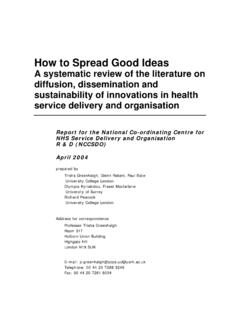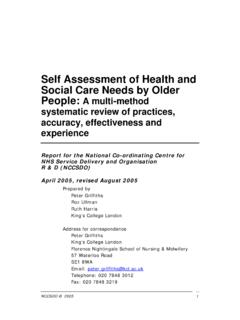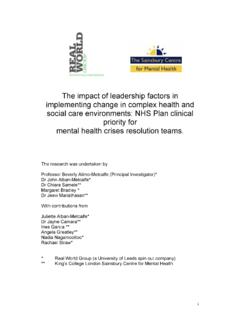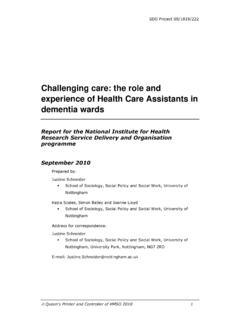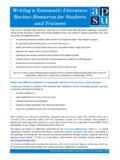Transcription of LEADERSHIP A REVIEW OF THE LITERATURE …
1 Institute of Governance & Public Management (IGPM) LEADERSHIP IN HEALTHCARE A REVIEW OF THE LITERATURE FOR HEALTH CARE PROFESSIONALS, MANAGERS AND RESEARCHERS July 2008 Commissioned by the National Institute for Health Research (NIHR) Service Delivery and Organization (SDO) Programme Professor Jean Hartley with Dr Jane Martin Professor John Benington Institute of Governance and Public Management (IGPM) Warwick Business School University of Warwick Coventry CV4 7AL Phone: (44) 24 76 574668 Fax: (44) 24 76 524410 Email: CONTENTS Acknowledgements 2 Executive summary 3 Introducing LEADERSHIP 34 The concepts of LEADERSHIP 47 The characteristics of LEADERSHIP 60 The contexts of LEADERSHIP 76 The challenges of LEADERSHIP 91 The capabilities of LEADERSHIP 117 The consequences of LEADERSHIP 139 From LEADERSHIP to LEADERSHIP development 157 Appendix: Methodology of the LITERATURE REVIEW 175 References 179 Institute of Governance and Public Management, Warwick Business School, University of Warwick 1 Acknowledgements The research team at Warwick Business School would like to thank a number of people who helped with this REVIEW , by discussing ideas with us, making suggestions and reading through earlier drafts.
2 The Project Advisory Group and others gave initial and continuing advice throughout the project and a number read through an earlier draft. The following have advised, contributed to workshops and/or read earlier drafts: Dr Stuart Anderson, Deputy Director, Research, SDO Cynthia Bower, formerly Chief Executive of West Midlands Strategic Health Authority, now Chief Executive, Quality Care Commission. Elisabeth Buggins, Chair, West Midlands Strategic Health Authority Sophia Christie, Chief Executive, North East Birmingham Primary Care Trust Professor David Cox, Chair, South Birmingham Primary Care Trust Professor Bernard Crump, Chief Executive, NHS Institute for Innovation and Improvement Professor Keith Grint, formerly Cranfield University, now at Warwick Business School. Emma Hawkridge, Press Office, SDO Liam Hughes, National Advisor for Healthy Communities, Improvement and Development Agency for Local Government. Jake Lyne, Clinical Director, Selby and York Psychological Services Sue James, Chief Executive, Walsall Hospital Trust Professor Peter Spurgeon, Warwick Medical School Tamar Thompson, Director of Nursing and Workforce, West Midlands Strategic Health Authority Heinrich Volmink, Men s Health Care Officer, Scotland Library and bibliographic help was provided by: Erin Withers, formerly Research Fellow at the Institute of Governance and Public Management Dr Layla Branicki, Warwick Business School Secretarial and further bibliographic help was provided by: Yvonne Field Dr Jane Martin contributed to the LITERATURE REVIEW and the drafting of some chapters.
3 The work was undertaken while she was a Senior Research Fellow at IGPM and she now works for the Local Better Regulation Office. Professor John Benington contributed to the analytical framework and the final drafting of the book. Institute of Governance and Public Management, Warwick Business School, University of Warwick 2 EXECUTIVE SUMMARY This executive summary is based on this book, commissioned by the National Institute for Health Research Service Delivery and Organization Programme. The research has been carried out by researchers at the Institute of Governance and Public Management (IGPM), at Warwick Business School, University of Warwick. The work has two key objectives: To REVIEW the LITERATURE on LEADERSHIP in healthcare and design a framework which synthesises the LITERATURE and provides a clear road map of the key areas of the LITERATURE and evidence. To draw out lessons for policy, practice and future research in the area of LEADERSHIP in health care.
4 The research and writing was carried out in such a way as to ensure that the evidence was both extensive and contemporary. The researchers: Reviewed the LITERATURE on LEADERSHIP and LEADERSHIP development, mainly but not exclusively in healthcare. This included a focused systematic LITERATURE REVIEW of the academic and policy LITERATURE of LEADERSHIP in healthcare in the last 10 years. Drew on wider LITERATURE about LEADERSHIP and LEADERSHIP development where it was felt to have direct relevance to healthcare. Tested the draft chapters with academics and practitioners in order to ensure that the book is clear, convincing and has practical applications. Ensured that the REVIEW is contemporary by contacting key UK and international researchers in the field of LEADERSHIP and healthcare LEADERSHIP for their latest work. This executive summary is also available as a free-standing document. This book will be of interest to anyone who exercises LEADERSHIP in relation to healthcare.
5 This will include those who have a formal LEADERSHIP position in a healthcare organization ( chief executive, clinical director, doctor, Institute of Governance and Public Management, Warwick Business School, University of Warwick 3nurse manager) or those whose LEADERSHIP is through influencing opinions and actions relevant to healthcare ( local government elected members and officers, patient groups). This book examines the degree to which there is an evidence base for ideas and practices about LEADERSHIP and to apply rigorous thinking to how such ideas can be applied. Evidence-based medicine has gained considerable ground over recent years, and there is a growing interest in evidence-based management as well. Of course, being located in social science not medical science means that the evidence base for LEADERSHIP will always be more ambiguous and open to varied interpretations than medical science. However, having a clear sense of which LEADERSHIP ideas and practices are rooted in theory and evidence, and which are more speculative, can be very helpful for healthcare leaders surrounded by conflicting advice, or being urged to behave in particular ways because it is fashionable.
6 Having a clear road map of the terrain of LEADERSHIP will help to avoid at least some of the pitfalls, fallacies and fantasies about LEADERSHIP . A FASHION FOR LEADERSHIP ? LEADERSHIP is currently quite a trendy topic. This is true across the private, public and voluntary sectors, with new books and articles being published by the day. The interest in LEADERSHIP is very evident in the public sector. There has been a series of policy-papers asserting the importance of LEADERSHIP in public service improvement. In the last decade, a number of dedicated LEADERSHIP centres have been set up for particular public service sectors including central government, local government, schools and police amongst others. Health is no exception to this interest, where LEADERSHIP is seen as central to improving the quality of health care and the improvement of organizational processes. The NHS Plan, produced in 2000, argued for more attention to be paid to LEADERSHIP and the development of leaders.
7 More recently and very prominently, the Darzi report (High Quality Care for All) places considerable emphasis on healthcare LEADERSHIP , especially but not Institute of Governance and Public Management, Warwick Business School, University of Warwick 4exclusively by clinicians as the NHS tackles new challenges. From the opposite end of the argument, some of the high profile media cases of lapses in professional care have, in part, been attributed to LEADERSHIP problems. Is LEADERSHIP just a fashion, which is blowing through the healthcare sector and will blow out again? Is it just new fancy language to describe what has always happened in hospitals, surgeries and schools across the land? We think there are several reasons why LEADERSHIP across the organization and across healthcare networks needs to be taken seriously: There are new challenges in healthcare - the kinds of illnesses are changing.
8 For example, the major post-war curable diseases, such as measles and diphtheria are largely conquered but instead chronic and multiple diseases associated with a larger elderly population, and chronic diseases due to lifestyle choices (such as obesity and smoking) are becoming more important. How can LEADERSHIP be used to anticipate rather than just react to changes in demographic and disease profiles? There are new health goals. Partly due to the changing nature of illness but also to address longer-term pressures on budgets, predict and prevent become more important goals alongside treatment . Health not just sickness is of concern. Healthcare in the community not just in hospitals and clinics is important. Public health may be moving to the centre of health policy - and working with partner organizations becomes increasingly important. How can LEADERSHIP be deployed to shape these new goals, and to ensure that there is a close link between ideas and practice on the front-line and between different partners?
9 The expectations of patients, carers and communities are shifting, with more widespread knowledge about health available via the internet, less deference for professional authority, and higher expectations of personalised and flexible care. What are the implications for healthcare organizations and their staff and how can Institute of Governance and Public Management, Warwick Business School, University of Warwick 5leadership be used to ensure that these changes are responded to appropriately? There are new techniques and technologies in healthcare, requiring new ways of working within and across teams, and with patients. Who can lead such changes and how might they be carried out? The organizations of healthcare are changing not only new structures, such as Foundation Trusts, but also, in places, new cultures and ways of working. How might such changes be led?
10 New approaches to continuous improvement, which rely as much on people management as on the techniques themselves, are being introduced. How can leaders support staff to make and sustain improvement efforts, in order to improve the service to the patient? New thinking about LEADERSHIP is helping to shift thinking away from a one best way model of LEADERSHIP but rather thinking about a range of approaches and methods. These are just some of the reasons why LEADERSHIP is important in healthcare. A FRAMEWORK FOR THINKING ABOUT LEADERSHIP Much writing on LEADERSHIP is very descriptive and anecdotal. For example, LEADERSHIP manuals and books often begin with a set of prescriptive behaviours, competencies or qualities required in leaders, and some assertions about the impact that LEADERSHIP has on team or organizational performance. A large number of books and articles on LEADERSHIP consist either of a list of ideal traits or behaviours, without any theory or context.
